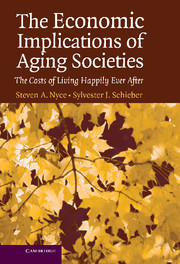Book contents
- Frontmatter
- Contents
- List of Figures and Tables
- Preface
- Acknowledgments
- 1 Introduction
- 2 Population Developments in a Global Context
- 3 Pension Options, Motivations and Choices
- 4 Pension Structures and the Implications of Aging
- 5 Retirement Systems and the Economic Costs of Aging
- 6 Beyond Pensions to Health Care Considerations
- 7 Labor Supply and Living Standards
- 8 Too Many Wants or Too Few Workers?
- 9 Alternatives to Finding More Workers
- 10 Aligning Retirement Policy with Labor Needs
- 11 Funding Pensions and Securing Retiree Claims
- 12 Macroeconomic Policies for Improved Living Standards
- 13 Risks Associated with Alternative Public Policies
- 14 Roadmap to the Future
- Index
5 - Retirement Systems and the Economic Costs of Aging
Published online by Cambridge University Press: 09 August 2009
- Frontmatter
- Contents
- List of Figures and Tables
- Preface
- Acknowledgments
- 1 Introduction
- 2 Population Developments in a Global Context
- 3 Pension Options, Motivations and Choices
- 4 Pension Structures and the Implications of Aging
- 5 Retirement Systems and the Economic Costs of Aging
- 6 Beyond Pensions to Health Care Considerations
- 7 Labor Supply and Living Standards
- 8 Too Many Wants or Too Few Workers?
- 9 Alternatives to Finding More Workers
- 10 Aligning Retirement Policy with Labor Needs
- 11 Funding Pensions and Securing Retiree Claims
- 12 Macroeconomic Policies for Improved Living Standards
- 13 Risks Associated with Alternative Public Policies
- 14 Roadmap to the Future
- Index
Summary
The discussion thus far has suggested that the way pension systems are structured might affect the costs associated with aged dependency. Lawrence Thompson of the Urban Institute cautions that analyses of this sort can often be misleading. He suggests that pensions are financed by a combination of contributions from labor income and returns on capital. He says that if a “lower charge to labor is offset by a higher charge to capital income, the total cost to the economy is the same even though it may be distributed differently.”
Thompson argues that the economic cost or burden of supporting a retired population is simply the total consumption of retirees divided by the total production in an economy. He expresses this relation as the product of three ratios. The first ratio is simply the consumption rate for all consumers in the economy relative to total output – i.e., the share of total output consumed rather than saved. The second ratio is the percentage of the total population that is retired. The third is the consumption rate of the elderly compared to people generally. The mathematical derivation of the retiree burden rate as equivalent to the consumption rate of the retiree population relative to total output is shown in Figure 5-1.
The economic burden that retiree populations impose on their national economies is driven by the variables in these ratios.
- Type
- Chapter
- Information
- The Economic Implications of Aging SocietiesThe Costs of Living Happily Ever After, pp. 107 - 128Publisher: Cambridge University PressPrint publication year: 2005



